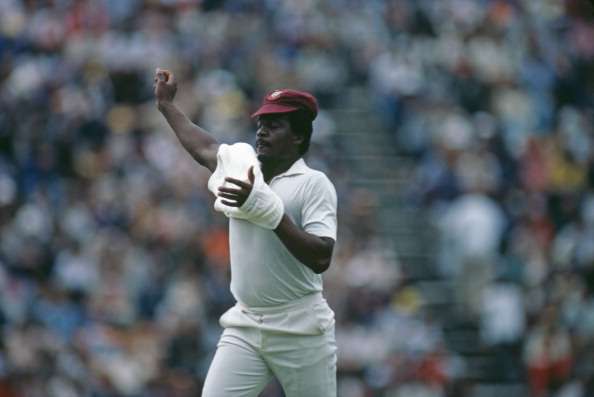Garfield Robinson looks at cricket’s fear factor, whether from fast bowlers or dashing strokeplayers
Fast bowlers have always sought to intimidate batsmen. “Pace like fire,” was a routine cry in the days when Australia’s Lillee and Thomson and the various four-pronged assemblies of the West Indies bullied the opposition. The batsman paralysed by fear will not be a formidable opponent.
Sylvester Clarke, the Barbadian pace man who represented Surrey for many years, was as frightening as they come.
An acquaintance related that as a 17-year-old he was called to trials for the Barbados team. Excited, he turned up early and soon found himself squaring up to Clarke. Given the scare of his life, he did not return the next day. “I just didn’t have the stomach,” he admitted.
Clarke was then only 21 and his fearsome reputation not yet forged.
Stories abound of players going to great lengths to avoid the man often described as the nastiest of the West Indian fast bowlers. County batsmen spoke his name in whispers, and whenever he was in the vicinity, some batsmen were sure to make themselves scarce.
Former Australian batsman and captain Steve Waugh tells of a 1987 sojourn in county cricket to prepare for the 1989 Ashes series. Clarke, he offered, bowled “the most awkward and nastiest spell” he ever faced.
Representing Somerset, Waugh related how tense his colleagues were before a game against Surrey: “All week in the lead-up to that match, the Somerset boys had been talking about the ferocity and ‘strike rate’ of Clarke. By strike rate, they were referring not to the wickets he took but to the number of helmets he cracked per game.
“As the contest drew nearer, I could see the determination of the players disintegrating, and by the time we pulled on the whites half the boys were already out. Pace and bounce of the kind Clarke could muster is something you can’t prepare for; it’s an assault both physically and mentally and the moment you weaken and think about what might happen, you’re either out or injured.”
Viv Richards, who had beaten back Jeff Thomson at his fastest, admitted that Clarke’s pace and steep bounce caused him concern. Graham Gooch had his helmet split by the big bowler. Simon Hughes, the Middlesex seamer, insists his helmet saved his life when Clarke clanged the portion protecting his temple.
Colin Croft, in Pakistan representing the West Indies alongside Clarke in 1980, recalls that he buffeted Zaheer Abbas, Majid Khan and Wasim Raja to such an extent that he believes Clarke hastened the retirement of two of the three. One bouncer disturbed Zaheer’s helmet so badly that it left a three-inch deep indentation.
Warned once while playing for Surrey about intimidatory bowling, Clarke reminded the umpire, and everyone close enough to hear, that cricket was not a “ladies’ game”. The batsman was like a bug to be squashed and he did his utmost to make his adversary’s stay in the middle as uncomfortable as possible. That was his duty as a fast bowler and he did it forcefully, and well.
But can a batsman ever offer that same threat?
On the first morning of the recent Test at Hobart, Australia were put in by West Indies captain Jason Holder. By lunch they had raced to 120-3. David Warner, dismissed a few balls before the break, made 64 from 61 balls, striking 11 fours. Importantly, the players expected to take the bulk of the wickets for the visitors, Jerome Taylor and Kemar Roach, were limited to just four overs apiece, conceding 25 and 33 runs respectively.
Warner’s full-blooded attack meant they were never allowed to settle into any kind of rhythm.
In Melbourne, Warner thumped 23 from 12 deliveries on the first morning, again pushing the bowlers early on the backfoot. Roach’s first three balls were slammed to the boundary, and when the batsman faced Taylor the next over, fours were bludgeoned off the first and third deliveries.
The third Test in Sydney was spoiled by the weather. Replying to the West Indies’ first innings 330, Australia reached 176-2. Warner, on an outfield slowed by rain, was 122 not out from 103 deliveries.
Earlier, the New Zealanders suffered. The first Test was at Brisbane, and if he was more circumspect than usual in making 163 at a strike rate of 72.76 in the first innings, his second innings 116 came at faster than a run-a-ball.
The first two balls he received from Trent Boult at Perth were dismissed to the boundary, the first 40 using up 32 deliveries. His eventual, mammoth 253 was made off 286 balls.
Many other similar instances could be cited, but it is enough to say that Warner makes a habit of making big scores at unbelievably rapid rates. In so doing he has often, I would suggest, traumatised many bowlers. Bowlers have now come to accept that full toll will be exacted for the slightest error in length or direction, and even blameless deliveries are often brutally punished.
So what’s a bowler to do? Imagine yourself going to bed knowing you’ll be facing the Australian opener in the morning on a flat, benign surface, in conditions resistant to any kind of lateral movement. Do you rest well?
Or do you toss and turn all night knowing your bowling is likely to be treated as cannon fodder next day. Are you eager to face him, or would you rather avoid the contest if you had a choice? In short: are you intimidated at the prospect of bowling to Test cricket’s most belligerent batsman?
Putting the fear of being hit aside – though I was recently treated to the sight of a standing umpire donning a helmet – do batsmen like David Warner and Viv Richards intimidate bowlers the way bowlers like Clarke, Thomson and Mitchell Johnson did?
I believe that one reason the West Indies bowlers were so inadequate was the early battering they received from Warner and Co. Taylor, for example, was exceptional against Australia in the Caribbean, capturing 6-47 in 25 exemplary overs in Jamaica. He did okay in Sri Lanka, too, taking six wickets in the two Tests at an average of 23.5.
In Australia, Taylor was set upon early and never recovered. The highly skilled Jamaican took two wickets for 257 runs.
We don’t all react the same way to pressure. It is accepted, however, that bowlers pose a greater threat when they don’t have to contend with the fear of being taken apart. Batsmen facing the likes of Clarke often feared being maimed or worse.
Bowlers facing Warner might not be concerned about physical injury, but the intimidatory factor is no less real.
This piece originally featured in The Cricket Paper, Friday January 15 2016












